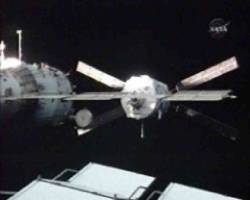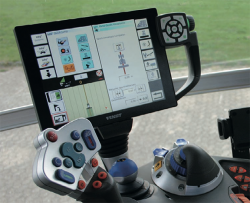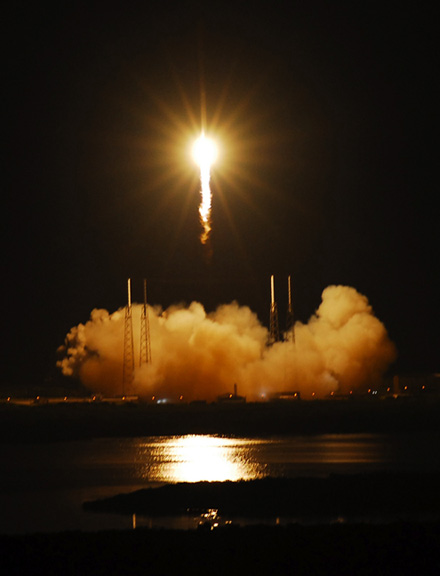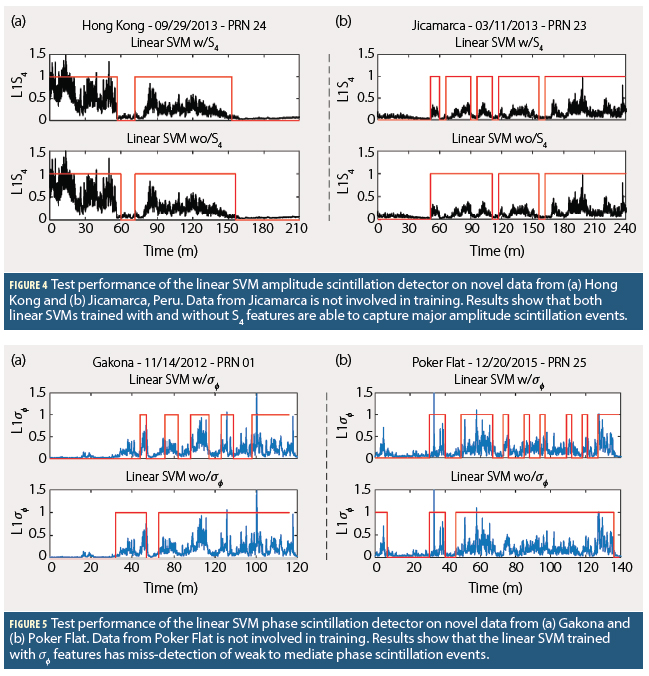 ATV Docking with International Space Station, NASA image
ATV Docking with International Space Station, NASA imageEurope’s Jules Verne Automatic Transfer Vehicle (ATV) that docked Thursday (April 3) at the International Space Station (ISS) is operating with a guidance, navigation control (GNC) system based on a GPS receiver developed by Thales Alenia Space Italia (TASI).
The GNC unit provides accurate position and velocity information for the ATV orbit control and rendezvous operation with the ISS. The Jules Verne completed its first space cargo voyage — 25 days long — docking the 10,470-kilogram (23,034-pound) ATV with the station, orbiting the Earth at 28,000 kilometers per hour.
According to the European Space Agency (ESA), this docking marks the beginning of Jules Verne’s main servicing mission to deliver cargo, propellant, water, oxygen and propulsion capacity to the station, as well as ESA’s entry into the restricted club of the partners able to access the orbital facility by their own means.
Europe’s Jules Verne Automatic Transfer Vehicle (ATV) that docked Thursday (April 3) at the International Space Station (ISS) is operating with a guidance, navigation control (GNC) system based on a GPS receiver developed by Thales Alenia Space Italia (TASI).
The GNC unit provides accurate position and velocity information for the ATV orbit control and rendezvous operation with the ISS. The Jules Verne completed its first space cargo voyage — 25 days long — docking the 10,470-kilogram (23,034-pound) ATV with the station, orbiting the Earth at 28,000 kilometers per hour.
According to the European Space Agency (ESA), this docking marks the beginning of Jules Verne’s main servicing mission to deliver cargo, propellant, water, oxygen and propulsion capacity to the station, as well as ESA’s entry into the restricted club of the partners able to access the orbital facility by their own means.
The unmanned spaceship maneuvered from a holding position 39 kilometers behind the 275-ton space station and conducted a four-hour staged approach with several stops at reference points for checks. It autonomously computed its own position through relative GPS (comparison between data collected by GPS receivers both on the ATV and the ISS). At close range it used videometers pointed at laser retroreflectors on the ISS to determine its distance and orientation relative to its target.
Final approach was at a relative velocity of 7 centimeters/second with a real-time accuracy of less than 10 centimeters, while both the ATV and the ISS were orbiting at some 340 kilometers above the Eastern Mediterranean. The approach and docking phase was piloted by the ATV’s onboard computers under close monitoring by the teams of ESA, CNES (the French Space agency), and Astrium (the prime contractor) at the ATV Control Centre at CNES Toulouse, France, as well as the ISS crew inside the Zvezda module.
According to TASI, the ATV GPS receiver is a space-qualified GPS orbit determination system that provides eight output states of navigation information for on-board autonomous guidance and control of low Earth orbiting (LEO) space vehicles.
After solar array deployment, the GPS Receiver was switched-on to set the ATV into its phasing configuration for the orbit transfer. The receiver achieved a cold start position first fix within 80 seconds of switch-on and continued uninterrupted operation up to the April 3 docking phase, according to TASI. Absolute positioning accuracy of better than 10 meters was achieved, well below the original expectation. The GPS receiver provides code and carrier phase measurements that are then processed by the ATV on-board navigation computer for relative navigation to the ISS.
The Thales Alenia Space Italia ATV GPS receiver features:
* a processing unit design based on a space-hardened processor technology
* optimized mechanical design to sustain shock, vibration, and temperature excursions
* a custom-designed ASIC implementing parallel GPS L1 C/A code channels
* external data I/F based on MIL-STD-1553B standard interface
* software features, including signal processing, GPS standard positioning providing a least squares all-in-view solution, filtered navigation solution providing osculating and mean orbit elements, and a flexible and configurable output data and rates.
The ATV can carry about three times as much payload as Russia’s Progress freighters that also service the space station. On this mission, however, most of the payload is actually propellant to be used by the ATV’s own propulsion system for periodical maneuvers to increase the altitude of the ISS in order to compensate its natural decay caused by atmospheric drag.
If required, the ATV will also be able to provide redundant attitude control to the ISS or even perform evasive maneuvers to move the Station out of the way of potentially dangerous space debris, according to ESA. The first of ATV Jules Verne’s reboost maneuvers is currently scheduled for April 21.“The ATV is so much more than a simple delivery truck, it is an intelligent and versatile spaceship which has just demonstrated its extraordinary skills,” said Daniel Sacotte, ESA’s Director for Human Spaceflight, Microgravity, and Exploration.
“It is the largest and most complex spacecraft ever developed in Europe and the second in size of all the vehicle’s visiting the Station, after NASA’s space shuttle. With Columbus and the ATV, we have entered the major league of the ISS.”





